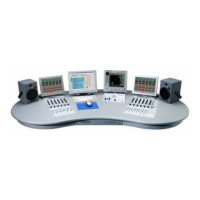OnAir 3000 Digital Mixing Console
Operation 5-87
Document generated: 10.10.14
SW V6.0
To simplify talkback to several destinations at a time, up to four talkback
groups can be setup easily (see chapter 5.5.3.1).
The input configured as ‘TB Source = CR’ is the audio source for talkback
from the CR. This can either be the internal TB microphone or any desired
input.
The talkback return signal can be listened with the internal speaker and/or
the DJ headphones.
Fader Strip TB Key In general, each fader strip has a TB key for that particular channel. In default
mode, the input routing defines the talkback destination. However, it is con-
figurable what the destination shall be. In cases where talkback does not make
sense (e.g. if the source is a CD player), the button can be used for another
purpose, as described in chapters 4.3 and 6.5.1.
TB GRP For grouping multiple TB destinations on one single desk key; for details
refer to chapter 5.5.3.1.
SLATE Allows talkback to the three main buses (PRG A, PRG B, REC).
In order to prevent talkback from going to these destinations unintention-
ally, the SLATE key must be pressed together with the PRG A, PRG B, or REC
master talkback keys.
The desk SLATE function is independend from the one on the main screen’s
MON - TB SP page.
Studio Talkback The control interface to the studios can be configured via the GPIO function
pool, where different inputs for talkback destination selection from the studios
are available. Possible destinations are:
• ToCR
• ToTelephone1(N–X)
• ToTelephone2(N–X)
• TootherStudiox
• TootherStudioy.
Inputs configured as ‘TB Source = Studio(x)’ are the audio sources for talk-
back from the studio(x). Four talkback sources per studio are supported, they
are mixed together in the console.
Talkback to the studios is listened over the studio speakers and headphones.
The signaling and the talkback sources can be defined separately for each
input if required; this is done in the configuration tool.
Signaling of Incoming Talkback If incoming talkback is activated, the corresponding TALKBACK key illumi-
nates. Incoming talkback is also displayed by the fader strip TB (or Joker)
key, if available and configured, and by the Joker button on the CHAN - FDR
Bus Page, if configured. For details refer to chapter 5.5.3.1.
MPX Conference Full MPX (conferencing) talkback functionality is implemented as an option
for SW V2.2 and up. For details refer to chapter 5.5.5.
For SW V3.0 and up, talkback to an MPX conference as well as to a CMS
waiting room can be performed using a ‘hidden channel’, i.e., a DSP channel
without a fader, instead of an external PFL input to listen to the conference.
Red-Light Signaling The red-light indicators ON AIR, CR, and (studio) 1 - 3 are contained in the
monitoring/TB module as well as on the main screen. For details, refer to
chapter 5.6.

